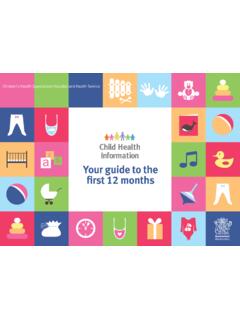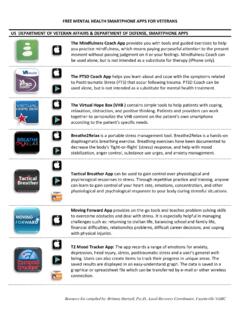Transcription of Child And Adolescent Development Module - UNHCR
1 Action for the Rights of Children (ARC)_____Child and Adolescent Development - Revision Version 04/01 FoundationsChild and Adolescent DevelopmentCONTENTSBRIEFING NOTES FOR 2 Topic 1: Defining Children and Childhood .. 6 Topic 2: Introducing Child Development Thinking into Programme 10 Topic 3: Risk and Resilience in Children and 15 Topic 4: Some Critical Threats to Child Development in Emergency Situations .. 20 Topic 5: Promoting Child and Adolescent Development in Programming .. 29 Topic 6: Action in the Best Interests of the Child .. 35 Topic 7: Child and Adolescent Participation .. 41 Sample 47 TRAINING MATERIALSO verheads .. 55 Exercises .. 80 Handouts .. 128 RESOURCESF urther Readings and Websites .. 131 Action for the Rights of Children (ARC)_____Child and Adolescent Development - Revision Version 04/01 Page 2 Child and Adolescent DevelopmentIntroductionFacilitators who have not recently trained or worked in the area covered by thisResource Pack, should read carefully through the various Topics, Overheads,Exercises, and Handouts before starting to plan their training activity.
2 Please notewhen using these materials, that they are to be used in conjunction with statedpolicy (they do not replace it) and aim to stimulate learning and and adolescents are not short adults - they are qualitatively have physical, psychological and social needs that must be met to enablehealthy growth and Development . The extent to which parents, the family, thecommunity and the society are able to meet these developmental needs (or not)has long-term consequences for the kinds of adults they will become. Armedconflict, displacement, disruption of normal life, and separation from family and/orcommunity can have powerful, long-lasting effects that need to be compensatedfor in protection and assistance interventions. The fact that almost half of thepeople of concern to UNHCR are children and adolescents, gives quantitativesignificance to these operational and adolescents are not a homogenous group.
3 While they share basicuniversal needs, the expression of those needs depends on a wide range ofpersonal, social and cultural factors. The protection and assistance interventionsof UNHCR and its partners are less likely to achieve their intended impact if apopulation of concern is treated as an undifferentiated group. To be effective, anunderstand is necessary, in a given situation, of what differences among gender,age, maturity, social class or caste, cultural or religious background haveoperational implications. Taking these factors into account is basic to need the care, protection and guidance which is normally provided byparents or other care-givers, especially during the early years when they are mostdependent. While their emerging abilities and capacities change the nature of thisvulnerability from infancy through adolescence, their need for attention andguidance at each stage remains.
4 Parents and communities have the primaryresponsibility for protecting and caring for their children, and initiating them intoculturally relevant skills, attitudes and ways of thinking. Interventions by outsidersare significant largely to the extent that they strengthen (or inadvertentlyundermine) family and community capacities to provide this care and are some circumstances where the urgent needs of children or adolescentsmust be met directly, but maintaining a long-term view is essential to finding waysAction for the Rights of Children (ARC)_____Child and Adolescent Development - Revision Version 04/01 Page 3to enable families and communities to care for and protect their children on an on-going CONCEPTSThe following are the key concepts, which are addressed in this Resource can also be found in Overhead There is no universal definition of children or of childhood.
5 Childhood is acultural and social construction, and not simply a universal stage in the humanbeing s physical and psychological Children and adolescents have needs and capacities that are significantlydifferent from those of Although certain general features of Child Development are predictable, thereare significant cultural differences in the ways in which children andadolescents develop, and in the beliefs, goals and expectations and Child -rearing practices that shape Gender differences are especially significant, as are differences related tosocial status, class/caste and specific needs related to It is important to integrate both a Child rights and a Child developmentperspective into programme Armed conflict and forced migration are likely to impose various risks whichmay have a particularly serious impact on children s Development : these riskscan be both multiple and Children and adolescents also have the capacity to be resilient in the face ofadversity.
6 The concept of resilience directs attention to those factors within theindividual, the family and the wider context which help people to cope Strengthening supportive networks may be the most effective way of enablingchildren and their families to cope with adverse Conflict and migration can pose some particularly critical threats to thedevelopment and well-being of children and adolescents: these includeexperiences of violence and fear; separation from parents or other care-givers; exploitation and abuse; and involvement in fighting In situations in which children s Development is under threat because ofsudden displacement, a high priority should be given to restoring a sensenormality in their lives and by protecting them from further threats to The Best Interests of the Child is an important principle in both legal and childdevelopment contexts, and can be applied to individual children and moregenerally in programming.
7 But implementing it sometimes requires handlingcomplex and contradictory As well as being an important legal right, Child participation can promote childand Adolescent Development and can enhance decision-making about youngpeople. Clarity of objectives and methods, a careful consideration of issues ofAction for the Rights of Children (ARC)_____Child and Adolescent Development - Revision Version 04/01 Page 4culture, gender and age, and the real commitment by the adults involved willgreatly facilitate effective implementation of this important AND DEFINITIONSThis resource pack does not aim to offer a comprehensive account of Child andadolescent Development : rather it seeks to provide some introductory materialwhich relates particularly to some of the critical isues facing children with arefugee background. It is mainly knowledge based: facilitators will find manyreferences to other ARC Resource Packs and may find it helpful to turn to theseboth to amplify some of the issues and to find more skill-oriented Convention on the Rights of the Child defines Child as everyone under theage of 18 unless, under applicable law, majority is attained earlier (Article 1): formost purposes in this Resource Pack, this definition is adopted.
8 However, asTopic 1 argues, the concept of childhood is understood differently in differentcultural and social contexts. Child Development , or Child and Adolescent Development refer to the processof growth and maturation of the human individual from conception to term adolescence has particular connotations in particular cultural andsocial contexts. In this resource pack, it is used to describe young people who arein the stage of Development that occurs between the beginning of puberty untiladulthood, without any implication that this period is characterised by anyparticular behaviour or attitudes. However, a distinction between children andadolescents is sometimes necessary in order to highlight the particular issuesfacing older young people, whose needs can be, and are frequently, overlooked many cultures, the care of children is shared among a wider group of adults,and often older children, than is common in western societies.
9 The term carer , care-taker and care-giver are used interchangeably to refer to those peoplewho play significant roles in the care of Resource Pack introduces the key concepts of risk and resilience : riskrefers to any factor or circumstance which poses any kind of threat to the normaland healthy Development of the Child , while resilience is defined as the capacity ofthe person to cope with risk or adverse circumstances. The term normal ,however, should be understood as indicating the norms of the particular society orcommunity, and not referring to any supposed universal OF THE RESOURCE PACKThis Resource Pack provides an introduction to some aspects of childdevelopment to inform and complement the material contained within the ARCC ritical Issues Resource Packs. It is organised in seven topics:Topic 1 argues that there is no universal definition of who is a Child , Adolescent oryouth, and that the concept of childhood is understood differently in differentcultural and social 2 considers the process of Child Development and the importance ofintegrating both a Child rights and a Child Development perspective intoAction for the Rights of Children (ARC)_____Child and Adolescent Development - Revision Version 04/01 Page 5programme planning.
10 It demonstrates how children s needs and capacities aresignificantly different from those of adults, and that armed conflict anddisplacement are likely to have a particularly serious impact on children 3 introduces the concepts of risk and resilience in children and adolescents,and outlines some approaches which may reduce risk and enhance 4 examines some particularly critical threats to children s Development :experiences of violence and fear; separation from parents or other carers;exploitation and abuse; and young people s involvement in fighting 5 outlines some strategies to promote Child Development in adverseconditions: these seek to restore a sense of normality, and to prevent 6 examines the important concept of the Child s Best Interests andconsiders some of the issues involved in implementing 7 looks at the principle of Child and Adolescent participation from both alegal and Child Development perspective.
















